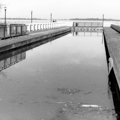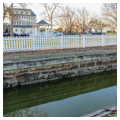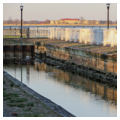So potently does the canal divide Delaware into northern and southern cultural zones, it is sometimes hard to recall that it is a man-made feature. Eighteenth-century Philadelphians clamored for such a transpeninsular waterway, as it would open them to western markets via the Susquehanna River, and one was abortively begun by Benjamin Henry Latrobe in 1804. In summer 1822, Latrobe's former pupil William Strickland surveyed two possible routes, Latrobe's and one farther south. After furious debate, the canal company chose the latter, to the surprise of many, and it was dug across Eastern Shore Maryland and Delaware in 1824–1829 (Benjamin Wright and John Randel Jr., engineers).
A force of 2,600 men at a time, Irish with some African Americans, did the work, cutting the fourteen-mile channel and building locks. The difficulties were enormous, as was the cost—about twice the original estimate of $1.2 million, and at $165,000 per mile compared to $19,000 for the Erie Canal. The canal cut 286 miles off a trip from Baltimore to ports on the Delaware River. The canal company never recovered from the enormous expenses of digging the waterway and remained in debt until the Federal Government bought it in 1919 and undertook enlargement.
Several bridges are interesting, as is the rare surviving Delaware Tide Lock at Delaware City (PR20). As widened in the 1960s, today's sea-level canal is 450 feet wide and 35 feet deep. Complex electronic devices are used to monitor ship traffic, under the auspices of the U.S. Army Corps of Engineers at Chesapeake City, Maryland. A Canal Museum there occupies a historic pumphouse.
Writing Credits
If SAH Archipedia has been useful to you, please consider supporting it.
SAH Archipedia tells the story of the United States through its buildings, landscapes, and cities. This freely available resource empowers the public with authoritative knowledge that deepens their understanding and appreciation of the built environment. But the Society of Architectural Historians, which created SAH Archipedia with University of Virginia Press, needs your support to maintain the high-caliber research, writing, photography, cartography, editing, design, and programming that make SAH Archipedia a trusted online resource available to all who value the history of place, heritage tourism, and learning.




